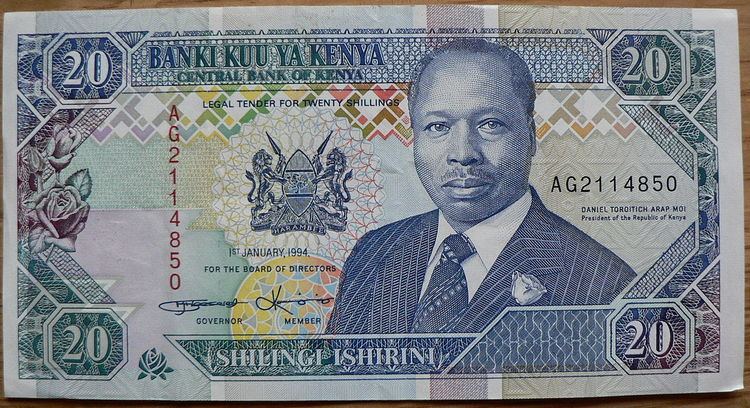Code KES Symbol KSh, /=, /-, K | Rarely used 5, 10, 20 shillings | |
 | ||
Freq. used 50, 100, 200, 500 and 1000 shillings Freq. used 1, 5, 10 , 20, 40 shillings | ||
The shilling (sign: KSh; code: KES) is the currency of Kenya. It is divisible into 100 cents.
Contents
Exchange rate
The exchange rate of the Kenyan shilling slumped dramatically in mid-2011, from about 83 shillings per US dollar to about 100 shillings per US dollar at late 2011 and to 105 shillings in September 2015. The Central Bank of Kenya shifted its target to tighten liquidity, including increasing interest rate and money market operations. But expected inflows due to tea export drove up the exchange rate to about 84 shillings per US dollar on 31 January 2012.
History
The Kenyan shilling replaced the East African shilling in 1966 at par.
Coins
The first coins were issued in 1966 in denominations of 5, 10, 25 and 50 cents, and 1 and 2 shillings; 25-cent coins were not minted after 1969 (except in the 1973 set); 2-shilling coins were last minted in 1971 (except in the 1973 set). In 1973 and 1985, 5-shillings coins were introduced, followed by 10-shillings in 1994 and 20-shillings in 1998.
Between 1967 and 1978, the portrait of Jomo Kenyatta, the first president of Kenya, originally appeared on the obverse of all of independent Kenya's coins. In 1980, a portrait of Daniel arap Moi replaced Kenyatta until 2005, when the central bank introduced a new coin series that restored the portrait of Kenyatta. The coins are 50 cents and 1 shilling in stainless steel and bi-metallic coins of 5, 10 and 20 shillings.
A bi-metallic 40-shilling coin with the portrait of President Kibaki was issued in 2003 to commemorate the fortieth anniversary of independence (1963–2003). New coins with the image of Kenyatta were issued in 2005. In 2010, Section 231(4) of the 2010 Constitution of Kenya stated "Notes and coins issued by the Central Bank of Kenya may bear images that depict or symbolise Kenya or an aspect of Kenya but may not bear the portrait of any individual." New banknotes and coins are scheduled to be released to meet up with this new law.
Banknotes
On 14 September 1966, the Kenyan shilling replaced the East African shilling at par, although the latter was not demonetised until 1969. The Central Bank of Kenya issued notes in denominations of 5, 10, 20, 50 and 100 shillings. All of the notes feature a portrait of Kenya's first prime minister and president, Mzee Jomo Kenyatta, on the front and diverse economic activities on the back.
5 shillings notes were replaced by coins in 1985, with the same happening to 10 and 20 shillings in 1994 and 1998. In 1986, 200 shillings notes were introduced, followed by 500 shillings in 1988 and 1000 shillings in 1994.
As with the coins, Mzee Jomo Kenyatta appeared on the banknotes issued until 1978, with Daniel arap Moi's portrait replacing him in 1980. In 2003, after Mwai Kibaki replaced Moi as president, 5, 10, and 20 shilling notes from the 1978 series with Kenyatta's picture that had been in storage were issued, and circulated for a time. A new series of notes was then introduced on which Kenyatta reappeared with denominations of 50, 100, 200, 500 and 1000 shillings. The issue of 12 December 2003 commemorates the "40 years of Independence 1963–2003". The banknotes are printed in Nairobi by De La Rue.
Proposed symbol redesign
In 2013, the Kenyan design agency Ark proposed a new symbol for the currency, which would use the uppercase letter 'K' representing Kenya, combined with two parallel lines to represent the "=" symbol. Arithmetically, the equality sign is a function that shows balanced relationships between items of the same value - a relationship that forms the basis of money as a medium of exchange. This equivalence "certifies" the stability of the Shilling.
The proposed Symbol was shared online and created a lot of interest within the general public and critics alike. It gained quite a lot of positive feedback with the Kenyan public praising the idea of finally having and owning their own signature symbol for the local currency.
